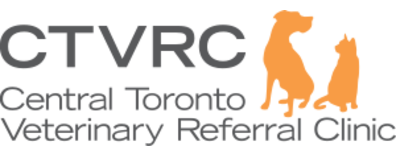Central Toronto Veterinary Referral Clinic

Client Education Sheets
What is megaesophagus?
Megaesophagus refers to a syndrome in which the esophagus does not function correctly. The esophagus is weak and then becomes much larger than normal. The esophagus function becomes compromised and it can no longer move the ingested air, food, and water into the stomach. As a result, they accumulate in the esophagus and cause it to be stretched.
What is the esophagus?
The esophagus is a tube that connects the mouth with the stomach. The muscles of the esophagus move the swallowed food and water to the stomach by using a squeezing movement behind the food known as peristalsis.
After swallowing, the normal esophagus is emptied within seconds. The opening of the esophagus is in the back of the mouth known as the pharynx, and sits next to the opening of the windpipe known as the trachea.
Why is megaesophagus harmful?
As the food, water, and saliva accumulate in the esophagus there is an increased chance that some can enter into the trachea and lungs causing a serious infection, known as aspiration pneumonia. Signs of aspiration can include a cough, labored breathing, nasal discharge, and/or fever.
Aspiration pneumonia can develop and the owner may never witness a regurgitation episode. Aspiration of food or water can unfortunately occur at any time, even if the dog has not been regurgitating for the last several weeks or months.
What are the symptoms of megaesophagus?
Many causes of this condition exist, but the consequences are similar regardless of the cause. Affected pets usually regurgitate fluid and/or food.
Regurgitation is different from vomiting in that it is a passive event that does not involve the retching or abdominal contractions that are commonly associated with vomiting. Regurgitation may occur immediately after eating or many hours later. Dogs with this problem may lose weight, depending upon how much food ultimately reaches the stomach.
How is megaesophagus diagnosed?
Megaesophagus is diagnosed by taking x-rays of the chest. If a megaesophagus is not detected a contrast agent may be fed to your pet to try to outline the esophagus on the x-rays.
What treatment is needed for megaesophagus?
Most commonly an underlying cause cannot be found, which is termed “idiopathic” megaesophagus. Underlying causes are found 15% to 25% of the time and the treatment of the underlying disease may allow the veterinarian to cure the megaesophagus. If a cause is not identified then symptomatic therapy is initiated. This mainly consists of trying to help food transverse the diseased esophagus and reach the stomach. If food does not remain in the esophagus, then it will not be regurgitated and aspirated.
It is recommended that feeding occurs from an elevated position where the upper body and forelimbs are elevated at least 45 ̊ relative to the hind limbs. The dog should remain in this position for 5 to 10 minutes after eating. By doing this, we hope that gravity will help pull food down into the stomach. Gruels are often fed in the hope that they will “slide” down the esophagus easier than dry foods.
A Bailey Chair, named for the inventor’s dog, is useful in encouraging appropriate and successful feeding techniques. A DVD with building instructions for the Bailey Chair, or an Internet connection to the DVD, can be obtained by contacting [email protected]. The cost of the DVD for the Bailey Chair is $6.60, which includes mailing, although it’s free with Internet access. Feeding several small meals a day is usually preferred to feeding one or two large meals. Rarely, drugs such as cisapride will help diminish regurgitation.
A tube can be placed through the skin and wall of the abdomen directly into the stomach (i.e., gastrostomy tube) so that the dog may be fed and watered without anything having to go through the esophagus. The placement of this tube is performed by a scoping procedure and is minimally invasive. This feeding technique does not eliminate all aspiration (the dog can still regurgitate the saliva it swallows), but it helps diminish aspiration. Sometimes gastrostomy tubes allow dogs with idiopathic megaesophagus to live a near-normal life.
What is the prognosis for dogs with Megaesophagus?
Owners frequently wonder how long their dogs can live with megaesophagus, and the answer is that as long as they can be kept a good weight and aspiration pneumonia attacks can be controlled, these dogs can live long, normal lives. For example, Bailey, of the Bailey Chair fame, died of lung cancer at almost 13 years of age.
Further information and support groups
http://www.baileychair.blogspot.ca
http://www.caninemegaesophagus.org
Michael Goldstein, DVM, Diplomate ACVIM
